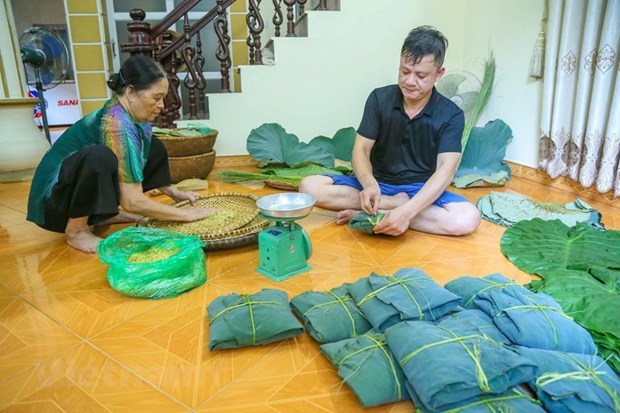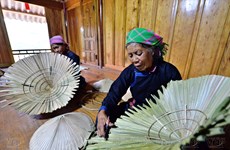‘Com’ - Delicacy that makes Hanoi’s autumn special
“Com” (young sticky rice flakes) is considered a must-have snack for Hanoians once autumn comes. To many, the green, fragrant, and light sweet flakes seem to hold the entire quintessence of the nature.
 Young sticky rice flakes made in Vong village of Hanoi’s Cau Giay district. (Photo: VNA)
Young sticky rice flakes made in Vong village of Hanoi’s Cau Giay district. (Photo: VNA)Each grain releases the light fragrance of young rice able to grasp the attention of any passers-by.
“Com” is made of young sticky rice reaped in either “chiem” (harvested in the fifth lunar month) or “mua” (harvested in the 10th lunar month) crops, but it is most delicious when the ingredient is “nep cai hoa vang”, an indigenous rice variety. People in Hanoi often use the rice of the “mua” crop to make “com” as it will give the dish a better taste.
In the capital city, the villages of Vong, Lu, and Me Tri are famous for their young sticky rice flakes.
When the pungent scent of milk flowers spreads across every corner of the city, signaling the arrival of autumn, it’s the time when Hanoians begin to make “com”.
In this time of the year, the villages become busier than normal as local residents have to work continuously overnight so that fragrant, glutinous, and warm rice flakes can reach buyers in the early morning.
Setting foot in “com” making villages this season, visitors can hear rice pounding sounds and smell the scent of young rice flakes coming from local households.
It takes a large number of meticulous steps to make a perfect batch of “com”.
 A household making “com” in Vong village in Hanoi’s Cau Giay district. (Photo: VietnamPlus)
A household making “com” in Vong village in Hanoi’s Cau Giay district. (Photo: VietnamPlus)After that husked rice will be pounded and continued to be sifted to remove the remaining husk. Pounding and sifting must be carried out for three times to make a clean batch of “com”.
The stoves for roasting young sticky rice flakes are covered with coal residues but use firewood, not coal, as fuel. Meanwhile, the roasting pans are often made from cast iron, which can ensure each grain will not be overcooked but soft, sticky, and fragrant.
Residents in Me Tri village said once the “com” making season comes, all family members are mobilised to produce this specialty, even from 4am until 10pm.
The finished product will be wrapped in lotus leaves so that the scent of both mixes with each other. “Com” lovers usually rub the grains in lotus leaves to enjoy that scent.
People often eat “com” directly or use it as an ingredient to make “com xao” (young stickly rice flakes cooked with sugar), “cha com” (rice flake meatballs), “xoi com” (steamed young sticky rice flakes), “banh com” (green sticky rice flake cakes), or “che com” (sweet tapioca soup with sticky rice flakes).
In particular, “banh com” is a must-try delicacy and also an indispensable part of every engagement ceremony in the capital city. The cake is made from young sticky rice flakes filled with mung bean, coconut flakes or candied lotus seeds.
“Com” is considered a gift of young rice and the quintessence of the nature. “Com” and “banh com” have also become special souvenirs visitors bring home whenever they set foot in the capital city./.













